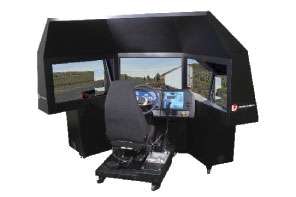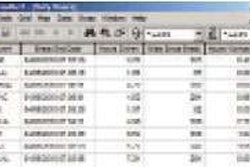Virtual training
Driver simulation software more mobile, adaptable
By Aaron Huff
Schneider National is nearing a decision point. Having trained thousands of drivers with simulators during the past five years, the technology has reached its expected lifespan.
Discontinuing the use of the simulators is not an option. Instead, management will decide whether to upgrade its existing hardware and software platforms or to replace them altogether with new technology. Whatever the final decision may be, the Green Bay, Wis.-based company says its experience has proven that the technology pays for itself.
 MPRI, in addition to its full-scale TransSim simulators, also offers “on-demand” computer-based training (CBT) modules that feature video and animation of real-life scenarios.
MPRI, in addition to its full-scale TransSim simulators, also offers “on-demand” computer-based training (CBT) modules that feature video and animation of real-life scenarios.Schneider’s use of simulators began with a pilot test of the MPRI TransSim system in September 2004. In February 2005, the company purchased simulators for all of its locations. As part of the pilot test, Schneider compared a group of new drivers trained with simulators to a group that did not receive simulation training. Where simulation was used, nearly 8 percent more drivers graduated from classroom training.
The higher graduation rate was due primarily to the fact that simulators provide an effective way to remove anxiety once drivers enter a big rig, especially with tasks like shifting. “A large truck is intimidating to someone who has not driven much before,” says Don Osterberg, senior vice president of safety, security and driver training.
Once drivers completed the initial classroom training, they entered an over-the-road phase with a certified instructor. Drivers who trained with simulators graduated at an 8.6 percent higher rate.
Once drivers completed training, Schneider compared the safety results of drivers during the first 90 days. The simulation-trained group had 31 percent fewer recordable crashes, and the driver retention rate was 14 percent higher.
The company uses an integrated learning model that consists of simulation, computer and instructor-led training. By leveraging simulators, Schneider calculated it is able to reduce fuel costs tied to instructor-led training and has saved $1.39 million in payroll by reducing the number of instructors from 188 to 164.
“Simulators will not replace the instructor,” Osterberg says. “But (simulators) are a very efficient way to train in the near term.”
Maximizing value
Besides using simulators for initial driver training and driver assessments, fleets can customize the technology to fit virtually any type of training need. Schneider has replicated some of the distribution centers for its dedicated accounts. By simulating the layout, drivers can be exposed to the unique requirements of a shipping and receiving center before they pull their first load.
“What we are trying to create is ‘I’ve been here before,’” Osterberg says.
Schneider also saves money by having drivers with the lowest fuel efficiency go through simulation-based miles-per-gallon training. In monitoring the results from a group of 976 drivers that received the training, Schneider documented a 2-percent increase in mpg. Annually, the savings came to $2,850 per driver, for a total of more than $2.78 million.
While full-scale simulators can be worth the investment, many small and midsize fleets do not have the budget to spend thousands on the devices.
Many fleets say the technology pays for itself.
MPRI, in addition to full-scale simulators, also offers “on-demand” computer-based training (CBT) modules that feature video and animation of real-life scenarios. These modules can be pushed out to the cab onto the latest generation of in-cab computing platforms.
The CBT modules can be used to show drivers the negative consequences of a bad decision, such as improper spacing or speeding, by simulating an incident that the driver experienced recently, says Jim Naatz, director of North America sales for MPRI.
For a fraction of the cost of full-scale driver simulators, J.J. Keller offers a PC-based simulation training tool called Safe Sim. The software comes with a car-size steering wheel and pedals, but it does not have the virtual reality to teach the basic mechanics of driving and shifting. The software is designed for teaching drivers how to drive safely.
Safe Sim can help safety managers identify unsafe habits in drivers, such as following too closely or not using directional signals. Drivers also can be tested on how they react to emergency situations such as icy roads, cars running stoplights or wildlife darting onto roads, says Joel Williams, product development manager.
Oncor Electric Delivery Co. uses Safe Sim as part of its driver training program. Oncor drivers operate equipment for building the electric transmission system in portions of northern, western and central Texas.
The company has a custom-built 22-foot air-conditioned trailer with eight Safe Sim stations. The mobile training site visits various locations to provide all 430 drivers with a 3½-hour safety training class once a year.
Jim Grudza, senior safety representative, says Safe Sim provides the “best bang for the buck” for including simulator training with its classroom training program. Drivers who get more than the allowable infractions in Safe Sim are required to take the simulation course again.
“With that approach, drivers take it a lot more seriously,” Grudza says.
IN BRIEF
* Affiliated Computer Services (www.acs-inc.com) will expand its capabilities this fall to provide safety and compliance data for drivers and fleets as mandated by FMCSA’s Comprehensive Safety Analysis 2010 through a partnership with Vigillo.
* Vigillo (www.vigillo.com), creators of data mining software products designed to deliver complex fleet safety information in an easy-to-read scorecard format, announced the availability of its new CSA Benchmark Scorecards. Provided at no additional cost, the feature allows fleets to compare the safety scores of their operations to other similar motor carriers.
* ALK Technologies (www.alk.com) announced the successful certification and integration of PC Miler 24 and PC Miler Tolls 24 by McLeod Software. The certification covers ALK’s street-level routing, multiversion switch and hazmat routing solutions.
* Prophesy Transportation Solutions (www.mile.com) announced the availability of a Web-based “pay as you go” dispatch software solution as part of the Prophesy DispatchSeries Software lineup.
* Accellos (www.accellos.com), a provider of supply chain execution software solutions, acquired the assets of Virtual Dispatch, a provider of on-premise and on-demand transportation management solutions.
* Rand McNally (www.randmcnally.com) introduced the latest enhancements to its GPS devices. One of the new features of IntelliRoute TND is state-by-state mileage data reporting, which allows drivers to track toll vs. non-toll miles by state or province for IFTA fuel tax reporting.
FMCSA amends EOBR rule
The Federal Motor Carrier Safety Administration last month amended several performance standards in its “Electronic Onboard Recorders for Hours of Service Compliance” final rule, which the agency issued on April 5. The changes were made after FMCSA received petitions from Qualcomm, Xata Corp. and a group of industry stakeholders, including the American Trucking Associations’ Technology & Maintenance Council EOBR Task Force.
The stakeholders requested changes for the temperature range in which EOBRs must be able to operate, and the connector type specified for the USB interface. Xata further requested that FMCSA clarify certain reportable events in the diagnostic table, and consider offering an additional alternative for the data transfer between an EOBR and a roadside safety official’s portable computer.
In response, FMCSA decided to delete the requirement for a specific operating temperature range from its final rule and also elected to delete the requirement for a Type B connector and replace it with a requirement for a Type A USB connector. FMCSA determined that it would be more appropriate to consider the fault-code reporting thresholds and alternative method for data transfer during the implementation period prior to June 4, 2012, the compliance date of the final rule.












